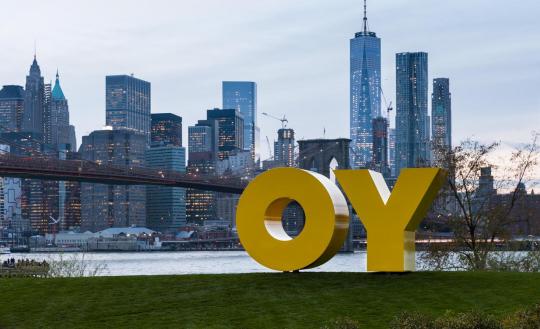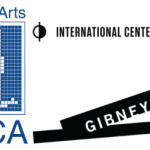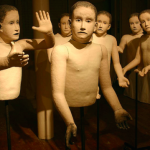Conversation with Deborah Kass
In January 2016, Deborah Kass (Fellow in Painting ‘91, NYFA Hall of Fame Inductee ‘14) will be giving an exclusive artists’ talk for NYFA supporters at the Paul Kasmin Gallery in line with her solo show No Kidding that opened on December 9. The exhibition includes Deborah Kass’ new mixed-media paintings incorporating neon lights for the first time, limiting her signature palette, to spell out puns and phrases bearing pop cultural references that provide a somber meditation on the troubling present, and uncertain future. It represents the artist’s fourth body of work that deals at the intersection of popular culture, contemporary art, art history, and politics. An extension of her Feel Good Paintings for Feel Bad Times, Kass’ most recent body of work sets a darker, tougher tone as she reflects on contemporary issues such as global warming, capitalism, police violence and racism, attacks on women’s health, through the lens of minimalism and grief.
In advance of the artists’ talk, we have spoken to Deborah Kass about her practice, her inspiration and her love of theater. For more information about the January 2016 artists’ talk, please email NYFA’s Senior Officer for Special Events & Individual giving, Ellen Claycomb at [email protected].
NYFA: Your body of work has recently taken a much darker and tougher tone. When did this shift start and how come it has gone so much darker?
Deborah Kass: Well, because I’m always interested in contemporary issues. There’s no difference really. It’s just that, you know, the other paintings were Feel Good Paintings for Feel Bad Times and now I just don’t feel good at all.
NYFA: Has it reached a point of overbearing negativity?
DK: It’s been a rough couple of years. For the world. All of these paintings, from the beginning, were very double edged. Now they’re just not so double edged any more.
NYFA: You received a NYFA Fellowship in Painting in 1991. You were also inducted into the NYFA Hall of Fame in 2014. I wonder if you remember your first impressions when you found out that you had become a NYFA Fellow?
DK: I definitely needed the money! You know, it was prestigious. Of course I was excited about it. I think it was the last grant that I got. It was a big deal. Those NYFA grants were a really big deal. They still are.

NYFA: We work with a lot of emerging artists, what advice would you pass along to those that are just starting out? Do you think they are coming into a different world than when you were starting out?
DK: Obviously. I started out in 1975. To say that it was a different world is a major understatement. And the ways in which it was a different world has been talked about by Patti Smith and everybody else. What the world was like in 1975. And ‘74 and ’76. I would advise people to go to a different city because I don’t know how you can possibly exist in this city anymore as an artist.
I was here for the 1977 blackout. I worked at Broome Street bar. It was SoHo back in the day. It was a completely different world. It changed so radically. I lived on West Broadway for 25 years. At one point, I realized that when you say ‘I have a loft in Tribeca’ it’s a completely different thing than what it used to be when you said you had a loft in Tribeca. People have a completely different understanding of those words. I lived in a really crappy fourth floor walkup that was really small. But it had beautiful light and it beautiful proportions. I felt like the luckiest person in the world to even get that then. Because it was so hard to find a place, even then.
NYFA: We also hear that you’re a very big theater person. Are there any upcoming shows that you’re excited about?
DK: The last thing I saw was The King and I and I’ve just got to see Hamilton. It’s number one on my list. I’ve got tickets for Fiddler on the Roof and I’m ecstatic and can’t wait. I generally spend for the special things like good seats and Barbra Streisand concerts. I’m really excited about Danny Burstein as Tevye in Fiddler. I love him.
NYFA: What does theater represent to you? Does it influence your creative practice as well?
DK: I’ve used the lyrics to Broadway shows in a lot of my work. It’s part of my work. The Great American Songbook is part of my work. The Great American Musical, post-war musicals, it is part of how I think about everything. It’s how I think about jazz. Music has a lot to do with my work. Lyrics have everything to do with my work.

Deborah Kass’ first monumental sculpture OY/YO is now installed in Brooklyn Bridge Park’s newly-renovated Main Street lawn. Commissioned by Two Trees and presented in partnership with Brooklyn Bridge Park, the sculpture will be on view through August 2016 and coincides with No Kidding at Paul Kasmin Gallery. OY/YO is sourced from urban and Brooklyn slang, the statement “I am” in Spanish, and the popular Yiddish expression, as a riff on Ruscha’s iconic word paintings.
Images, from top: Deborah Kass, photo credit: © Timothy Greenfield-Sanders; Deborah Kass, Black and Blue #1, 2014, acrylic and neon on canvas; Deborah Kass, OY/YO, photo credit: © Etienne Frossard





